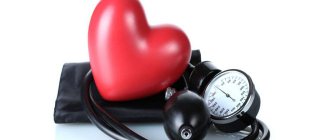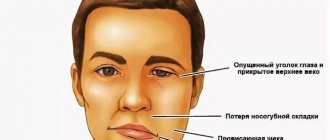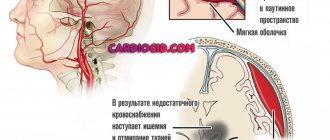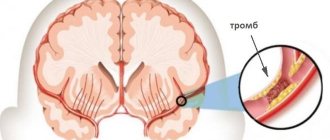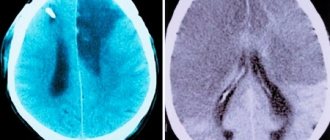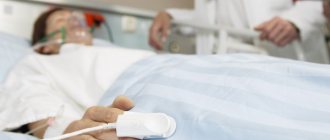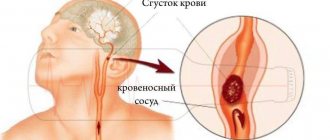A stroke is a reactive, acute disruption of the blood supply to the brain, accompanied by the rapid appearance of foci of necrosis. Depending on the time during which blood circulation is not restored to normal levels, the general prognosis of the patient’s life depends. The patient can die within hours. What a person’s life depends on, symptoms, stages, how they die from a stroke - all this is described in detail below.
Classifications of strokes
In practice, a simple classification is used, distinguishing two forms of stroke depending on the causes that gave rise to the hemorrhage: ischemic and hemorrhagic. In addition, stroke periods and severity levels are distinguished.
Ischemic stroke
Statistically, it occurs more often, up to 85% of all cases, appearing as a result of the closure of the lumens of blood vessels that supply a certain part of the brain. Closure of the vessel can occur due to a blood clot, atherosclerotic plaque, or due to narrowing of the walls due to severe spasm.
This type of stroke does not occur overnight. It develops progressively, one pathological process follows another.
- Blood flow decreases.
- There is a sharp release of glutamate and aspartate, excitotoxicity occurs (a pathological process that leads to serious damage and death of nerve cells under the influence of neurotransmitters).
- Calcium accumulates inside each cell.
- The activation of intracellular enzymes increases, the lack of oxygen progresses, and foci of local inflammation arise.
- Brain neurons die.
All stages occur with increasing cerebral edema, cells increase in volume, and intracranial pressure indicators increase. Because of this, local parts of the brain - the temporal lobes - are displaced, the midbrain is pinched, which leads to compression of the medulla oblongata (due to the entry of the cerebellum into the foramen magnum). With this development, death from a stroke is most often stated.
Hemorrhagic stroke
This form of stroke was once called “apoplexy.” Registered in 15% of cases. Formed due to a rupture of the vessel wall or an aneurysm. The cause may be a sharp jump in blood pressure or pathology in the walls of the vessels themselves. Spontaneous hemorrhage occurs in the brain tissue (in the subarachnoid space).
Hemorrhagic stroke occurs due to increased physical or emotional stress. If, after exertion, you feel severe headaches, your surroundings appear reddish, and nausea occurs, you can talk about the preconditions for a stroke.
With such a pathology that occurs in the brain stem, a person does not live more than 48 hours. He dies without regaining consciousness. External signs of death from a stroke: pale skin, sensations of approaching death, one half of the body, on the side where there was hemorrhage, is dark purple. This is one of the specific external manifestations of death from a stroke.
Periods of stroke
Cerebrovascular accident occurs over several periods.
- The most acute phase.
- Spicy.
- Early recovery period after stroke.
- Late recovery period after hemorrhage.
- Complications and consequences of hemorrhage.
- Long-term consequences.
Death most often occurs during the hyperacute and acute phases.
Severity
Depending on the size of the area of brain damage, there are three degrees of stroke severity.
- Small stroke (micro-stroke). Neurological pathologies appear, the symptoms are not expressed, they can be confused with manifestations of other fatal diseases.
- Light to medium severity. Focal symptoms can be observed; there are no signs of altered consciousness or cerebral edema.
- Severe degree. The patient is unconscious, neurological disorders progress rapidly, and severe cerebral edema occurs. This condition ends in death.
Important! Stroke is a dynamic process. The sooner the patient receives adequate, highly qualified medical care, the greater the likelihood of restoring the full range of brain functions. Hospitalization is necessary in the first three hours after detection of hemorrhage to prevent death.
Types of stroke
There are 2 types of stroke - ischemic or hemorrhagic. Ischemic is dangerous due to the death of brain cells, and hemorrhagic is characterized by hemorrhage into the brain tissue. Ischemic is called cerebral infarction. A tendency to this disease is observed in patients over 60 years of age. It is the most common and is diagnosed in 80% of patient visits. The factors influencing its appearance are associated with the creation of unfavorable conditions for the movement of blood through clogged vessels, delivering oxygen to brain cells.
At the same time , death from hemorrhagic stroke occurs most often among patients at the initial stage, in the first days of the disease. A large number of adverse outcomes occur after major or secondary stroke. A patient’s condition, incompatible with vital signs, is diagnosed when the respiratory system is damaged or the functioning of the heart muscle is impaired. This occurs when cells in the brainstem or cerebellum die. The patient's death is determined to be due to cardiac arrest and failure of the respiratory system.
Statistical data
Death due to stroke and signs of the early stage of the disease are being recorded more and more often in Russia. Stroke is rapidly getting younger. Factors affecting the unfavorable environmental situation in large cities, constant stressful situations at work and at home, and abuse of alcohol and tobacco products. In world practice, stroke ranks third in the overall statistics of all deaths, in Russia it ranks second.
A higher percentage of mortality is recorded from the hemorrhagic form of cerebral hemorrhage.
| View | Mortality percentage |
| Ischemic | 12-17% |
| Intracerebral hemorrhage | 53-83% |
| Subarachnoid | 33-65% |
The gender distribution of risk, or how men and women die from stroke, is as follows:
- death from stroke in women occurs in more than 43% of cases;
- men die less often – 36.6%.
Rehabilitation and prevention play an important role, because statistically the highest percentage of mortality is recorded after a recurrent stroke.
For information. Only 59.9% of patients who apply receive qualified and timely assistance. The rest self-medicate (34%), others do not receive help at all (5.7%).
What kind of disease is this
Hemorrhagic stroke, what is it? A hemorrhagic cerebral stroke, or sometimes mistakenly called a hemorrhoidal stroke, differs from an ischemic stroke in that ischemic is caused by a cessation of blood flow to the brain due to blockage of a vessel by a blood clot or cholesterol buildup. A stroke with bleeding into the brain is hemorrhagic. When it occurs, the walls of blood vessels are destroyed, allowing blood to enter the brain. The functioning of the brain is disrupted. Medical professionals also understand hemorrhagic stroke as cerebral hemorrhage. So what is a cerebral hemorrhage? Cerebral hemorrhage is the process of accumulated blood entering the brain tissue.
According to statistical studies, this disease is very common, took second place in all types of strokes and is a representative of its most dangerous type. This disease is common in older adults. Although currently hemorrhagic stroke is also observed in young people over the age of 30. As a rule, the disease occurs suddenly during the day with severe physical stress or mental stress. The consequences of a hemorrhagic stroke are paralysis or even death.
Hemorrhagic strokes are divided into 2 types:
- Hematoma. When bleeding occurs, a hematoma forms in the head. Intracerebral hemorrhage occurs in a specific area of the brain. The result of this process is the deformation of nearby areas of brain tissue, which causes disruption of their nutritional processes and the subsequent death of these areas.
- The second type of cerebral hemorrhage is called hemorrhagic impregnation. It involves the distribution of blood elements among brain cells. Compared to the first type, this one affects larger areas of the brain, but with this type of hemorrhagic stroke its consequences are milder than with a hematoma.
Intracerebral hemorrhage develops in two directions:
- The first direction is characterized by a rupture of the walls of blood vessels, during which blood is released, after a certain period of time a blood clot forms and blocks the vessel. Approximately this process lasts several hours. Although it may take several days.
- A stroke of the hemorrhagic type, which develops in the second direction, occurs due to loss of tone of the vessel walls, as a result of which blood leaks into the brain without breaking them. This process is called diapedesis.
Causes of stroke
The main causes of death in stroke (risk factors) include the following human conditions:
- an increase in blood pressure is permanently recorded, which also indicates an increase in intracranial pressure;
- hereditary factor: strokes have been reported in close relatives;
- excess body weight;
- smoking and alcohol abuse;
- vegetative-vascular diseases;
- a history of aneurysm;
- sedentary lifestyle (in bedridden patients, the risk of stroke increases);
- diseases of diabetes mellitus and atherosclerosis;
- paroxysmal headaches, and very severe ones;
- periodic numbness of any part of the body or face;
- the appearance of a dark veil before the eyes, temporary loss of vision;
- attacks of unexpected weakness.
Causes and risks
This pathology represents damage to one of the vessels with further hemorrhage into the brain tissue. Hemorrhage causes a series of damage directly to the lesion, as well as to surrounding tissues.
Specialized assistance should be provided no later than 3 hours from the onset of a stroke; sometimes the allowable time can increase to 6 hours. After this period, the consequences of the disease cannot be removed. First, doctors declare clinical and then biological death. If the patient manages to survive, then nothing but a vegetative state can await him.
Experts include the following as the main causes of hemorrhagic stroke:
- Hypertensive crisis. In most cases, the cause of this type of disease is hypertension.
- Vascular malformation. It can be congenital or acquired. In the first case, it poses a danger to a person throughout his life. Acquired occurs due to heavy loads or diseases. The risk group includes men of all ages.
One form of vascular malformation is an aneurysm. Its rupture often causes hemorrhage.
Factors influencing the development of various vascular deformations and hypertension:
- Diseases affecting blood clotting.
- Uncontrolled use of thrombolytics. Even with medical indications, drug doses must be observed, as well as coagulogram parameters must be monitored. Otherwise, the appearance of a microcrack in an artery or vein can cause rupture of the vessel and hemorrhage.
- High cholesterol levels cause the appearance of atherosclerotic plaques on the walls of blood vessels in the brain. This complicates blood circulation, increases pressure, which provokes the formation of small cracks and blood clots in the vessels. Stopping normal blood flow causes a stroke.
- Encephalopathy caused by viruses, toxins or allergies. It provokes swelling of the brain, cell death, and the formation of adhesions. The disease is characterized by a large number of complications.
- Amyloid angiopathy.
- Cerebral vasculitis.
- Heart diseases.
- Diabetes.
- Spinal cord diseases.
- Neoplasms in the brain.
Factors that accelerate the development of pre-stroke conditions include:
- hard physical labor;
- excess body weight;
- smoking;
- drug use;
- alcoholism;
- unbalanced diet;
- age;
- head or spine injuries;
- heat strokes;
- intoxication;
- prolonged exposure to stress.
The development of hemorrhagic stroke occurs instantly. The consequences for a person directly depend on the amount of blood that entered the brain from the damaged vessel. Only 20% of patients who suffer this form of stroke survive.
All basic reflexes are present, but no conscious activity is observed. The final stage is vegetative coma. Coma is a difficult test for the human body. Even the most experienced specialist cannot predict what awaits the patient after leaving it. Coma after a major stroke for a person ends with the following:
- loss of hearing, vision;
- paralysis;
- impaired thinking, confusion;
- disturbance of mental activity;
- loss of ability to perceive information and speak;
- recurrent stroke.
People after a hemorrhagic stroke experience the following consequences:
- coma;
- sopor;
- disability;
- partial/complete loss of motor function;
- impaired ability to swallow;
- damage to the speech center;
- disturbance of thinking and behavior;
- mental disorders;
- epilepsy;
- pain syndrome.
Symptoms of a stroke
Sudden focal neurological symptoms in combination with meningeal manifestations indicate the presence of an acute, severe disorder of cerebral circulation. The brain, not receiving enough oxygen and nutrients due to impaired blood supply, begins to change destructively; at first these changes are reversible, then these processes can no longer be reversed. That is why every person should know the signs of the disease and what death from a stroke looks like in order to provide timely help to a loved one or passerby. These symptoms include:
- an attack of severe headache or dizziness;
- paralysis of a part of the face or body, expressed in slurred speech, inability to control one’s movements, and impaired fine motor skills;
- loss of consciousness;
- various types of paresis;
- sudden complete or partial loss of vision;
- severe excess of normal pressure indicators;
- open vomiting and nausea;
- problems with the perception of surrounding reality;
- involuntary bowel movements or urination.
Important! If you suspect a stroke, you need to ask the person to smile, raise their hands up and say a simple phrase. If one of the corners of the mouth “slides” down, forming a crooked smile, the tongue “twists” during speech, and you cannot raise your hands, then urgent professional help is needed. In this situation, delay is like death.
A diagnosis can only be made by carefully studying the general clinical picture, medical history, risk factors, and neurological symptoms.
Signs of dying in a bedridden patient after a stroke
Before death, a bedridden patient feels a loss of strength and fatigue. As a result, the patient sleeps constantly. Sleep can be deep or light (with light sleep, voices and various other sounds are heard).
Before death, one feels and sees something that is not really there. Orientation in space is often lost and consciousness becomes confused. The patient becomes withdrawn and loses interest in everything that is happening.
The urine turns red due to poor kidney function, which also causes swelling. A bedridden patient breathes quickly and unstably. Due to poor blood circulation, venous spots appear. Initially they appear on the legs. Before death, the patient's limbs become cold as blood rushes to vital organs. All these are the main signs of approaching death.
Signs of a patient dying from a stroke appear on average after 15 minutes. Signs of death:
- the person does not respond and does not react to ammonia, as well as to blows on the cheeks;
- pupils do not react to light;
- the pupils become oval when squeezed from the sides;
- no pulse or breathing;
- the cornea of the eye becomes cloudy.
Signs of death during the first day:
- dry mucous membranes and skin;
- rigor mortis appears;
- the appearance of cadaveric spots;
- decrease in body temperature down to 25 ° C (in the rectum).
Doctors are confident that the risk of death can only be reduced by adhering to preventive measures. If you eat right, avoid bad habits, and check your health, you can avoid the risk of stroke. If a doctor notices early signs of a stroke that threaten the health of patients, then it is necessary to follow all the recommendations of doctors in order to never experience the full severity of this disease.
External signs of death from stroke
It is possible to determine that a person who has suffered a stroke is close to the end by external signs that indicate irreversible processes in the brain. Harbingers of approaching death are:
- disturbance of consciousness;
- unsteady gait, sweeping movements;
- the patient cannot speak, move, open or close his eyes;
- swallowing reflex is absent;
- there is inadequate motor activity, convulsions, twitching of the arms and legs, more like convulsions;
- increased body temperature - more than 40 degrees (indicates damage to neurons that regulate thermodynamics);
- eye movements are disturbed - by lifting the eyelid, you can see that the eyes seem to “float”, the pupil on the side of the hemorrhage is greatly dilated;
- high blood pressure, increased heart rate, bradycardia;
- appetite is reduced, stool is scanty and harder;
- urine is more concentrated and its quantity decreases;
- deep noisy breathing (Kussmauel breathing type), there are long pauses between inhalation and exhalation;
- breathing is sometimes deep, sometimes shallow.
Odds: Factors Affecting Survival
If we talk about severe comatose states after a stroke, then the chances of survival will be influenced by a lot of associated factors. We are talking about the age, gender of the patient, the presence of chronic diseases, the speed of medical care, the degree of damage to the cerebral hemispheres, the presence of cerebral edema and the type of stroke. This can only be said after hospitalization and differentiated diagnostics, which includes MRI, CT, ultrasound, collection of blood and cerebrospinal fluid. Then an appropriate course of treatment is selected and recovery time is calculated. The period in the first three weeks is especially important, then a year, and after that you need to achieve recovery and the absence of a second attack in the first two years.
Age
It's no secret that age matters in the treatment of diseases. Therefore, it is more difficult for patients over 60 years of age and newborn children to survive an attack, recover from it and restore normal functioning of the body. This happens due to the fact that their cells are almost not renewed, there is no possibility of performing operations, medications can be administered in a limited dosage, and symptoms appear suddenly.
Chronic diseases
The presence of chronic vascular diseases, pathologies of the heart and kidneys reduces the chances of recovery and life after a stroke. Since these factors often become the cause of the development of the disease. In addition, problems with blood vessels, joints and heart indicate difficulty in blood circulation, thrombosis and atherosclerosis. Then the damaged part cannot recover normally, which means that the body’s functions only partially return.
History of cerebral circulatory disorders
Circulatory disorders can be associated with high blood pressure, hypertension, atherosclerosis, pathology, traumatic brain injury, when aneurysms and hematomas form in the brain. Then there is a headache, migraine, nausea, loss of consciousness, problems with memory and vision. Which already indicates improper blood circulation, chaotic movement and blood clots. Taking a medical history (brain fluid) can provide clues about the causes and presence of problems.
Type of stroke
If an ischemic stroke or transient attack can be survived and recovered from the consequences even by pensioners, then after a hemorrhagic attack most patients become disabled, fall into a coma or suffer from cerebral edema. Rehabilitation and recovery can only restore part of the capabilities, since due to hemorrhage, neurons and cells suffer irrevocably and deeply.
Localization for hemorrhagic stroke
The location of the stroke foci during an attack is no less important; when the subarachnoid space, right hemisphere or cerebellum is damaged, the consequences are more extensive and serious. And when blood vessels in the spinal cord rupture, a person most often becomes disabled for the rest of his life.
Volume of hemorrhage
When the brain pools are completely flooded, the acute phase of a stroke develops almost instantly; there is no time left for medical care, since the cells die instantly. In this case, vivid symptoms and pain are observed; if the subarachnoid space, cerebellum, or basins of the left and right hemispheres are affected, then it may take at least a year to restore the affected part, with no guarantee of a complete recovery.
Type and size of affected vessels
If vascular ligaments in the spinal cord or arterial vessels are affected, then we can talk about severe brain damage, immediate development of the acute phase and death of brain cells. If the capillaries rupture, the hemorrhage will not be as large-scale, which means that the cerebral cortex is not so severely affected. In addition, it is much more difficult to restore the vessel, especially if they were torn, and not just clogged with blood clots.
Speed of assistance
But the speed of medical care is no less important, since slowing down or refusing hospitalization even after a mini-stroke threatens further development of the attack, death or coma
The process usually takes about two to four hours and it is important to begin rehabilitation of the condition immediately. Otherwise, the brain tissue suffers deeply and irrevocably
Brain swelling
Cerebral edema is a prerequisite for coma and indicates severe damage to the cerebral cortex, as the vessels were ruptured and hemorrhage began. In this state, a person loses the bulk of his mental and physical capabilities, the reaction to stimuli is reduced, and reflexes almost do not work. To summarize, the patient is in an unconscious state where functions only partially return, and death or coma often occurs within two to three days.
What does clinical death from a stroke look like?
If the ischemic process progresses, the prognosis will be unfavorable. There are three main signs (conditions) by which clinical death is determined. The first 4 minutes are decisive. After establishing the symptoms of clinical death, resuscitation measures are taken. If they are unsuccessful, the onset of biological death is recorded.
Additionally, the table shows what death from a stroke looks like.
| State | Short description |
| Coma |
|
| Apnea | Complete absence of respiratory activity, no respiratory movements of the chest. |
| Asystole |
|
Death after acute hemorrhage in the brain area can be caused by various reasons (from pulmonary edema to cardiac arrest). Only prevention of any pathologies of the cardiovascular system, blood supply, nervous system, a healthy lifestyle, as well as early diagnosis of stroke can help reduce the rate of death from cerebral hemorrhage.
An important role is played by the provision of competent assistance at the level of the local clinic, since often with the first symptoms of a stroke the patient turns to the doctor of this particular medical institution.
Patient care
A bedridden patient requires appropriate care. General hygiene procedures are recommended. The patient is advised to wash and brush their teeth regularly. Regular wiping of the body is necessary, especially in the summer. The patient needs assistance during bladder and bowel movements. It is recommended to wash the patient completely at least once a week. For this purpose, special dry shampoos are used.
The patient is placed on a bed with a hard mattress. The patient needs a gentle massage of the whole body every day. If there are folds in the bed linen, they need to be straightened out. The sheet should be changed once a day . In order to ensure a flow of fresh air, it is recommended to regularly ventilate the room in which the patient is located. Regular wet cleaning is also carried out in it.
The patient is fed in a semi-sitting position. To do this, pillows are placed under the head or the head of the bed is raised. After the patient has taken a few spoons of solid food, it is recommended that she be given something to drink. It is recommended to give the patient water through a straw, sippy cup or teapot. If lifting the patient is prohibited, then they are given only liquid food from a bottle onto which a nipple is first placed.
In bedridden patients after a stroke, bedsores occur. To eliminate this complication, it is recommended to regularly turn the patient over. His skin needs to be regularly examined and treated with appropriate cosmetic products.
If the patient is in a supine position, this can lead to disturbances in the digestive system, which are manifested by constipation. To eliminate them, it is recommended to massage the abdomen, use a diet and medications that are of plant origin. All these activities will help improve peristalsis.
Before death from a stroke, pulmonary congestion may be diagnosed. In this case, patients experience poor expectoration of viscous sputum. To avoid stagnation, breathing exercises are recommended . The patient should regularly inflate a balloon or blow through a straw into a glass of water.
If the patient is allowed a semi-sitting position, then it is used as often as possible. To avoid stagnation, a massage is recommended, which is carried out by tapping the chest.
After a stroke, a person may feel that their body is stiff. The cause of the pathological process is excessive brain damage. Mortality in such patients is common. Its occurrence is explained by untimely or improper treatment of stroke.
How to reduce the likelihood of death
First of all, you should avoid stress, states of emotional overstrain and worries. In the most unusual situations it is necessary to remain calm.
The risk of premature death from stroke can be reduced by leading a healthy lifestyle, closely monitoring your health, and promptly treating inflammatory and other diseases.
To reduce the negative impact of environmental factors, difficult climatic conditions of existence should be avoided. It is also necessary to limit the consumption of salt and animal fats, and organize a proper and balanced diet. Smoking and drinking alcohol is unacceptable!
General statistics on the disease
In 2020, data from an international project to study the global burden of diseases, Global Burden Diseases (GBD), was released. According to it, 10.3 million cases of stroke are registered annually in the world, of which 6.5 million are fatal . In 11.9% of cases (2nd place), the cause of human death is acute cerebrovascular accident.
Honored Doctor of the Russian Federation, Doctor of Medical Sciences, Professor, Head of the STOP-Stroke Service E. A. Shirokov analyzed data from major international studies (STONE, Syst-Eur, NICS) and came to the conclusion that in the structure of cardiovascular pathologies, strokes in our days prevail over myocardial infarctions in frequency by approximately 30% .
Academician of the Russian Academy of Sciences Gusev E.I. reports that ischemic strokes (death of brain tissue due to oxygen deprivation) predominate over hemorrhagic strokes (bleeding in the brain due to rupture of a vessel). Their share is 80%. Moreover, this trend is typical for most countries of the world (according to Donnelly R., Gardner I., Morris AD and others), including Russia.
According to the Research Institute of Neurology of the Russian Academy of Medical Sciences, drug therapy for hemorrhagic stroke is less effective than surgical therapy . Removal of brain hematomas through the precise insertion of electrodes or micropipettes into any point of the mental organ (stereotactic operation) gives a mortality rate of 21.1%, while the administration of drugs that normalize the nutrition of brain tissue and improve metabolic processes in it (piracetam, emoxypine and others) - 49. 1%.
The problem of recurrent stroke is becoming increasingly important, since the latter increases the likelihood of death. According to Gubitz G. and Sandercock P., the probability of recurrence of acute cerebrovascular accident is highest during the first year after an ischemic stroke and averages 10% . Each subsequent year the risk increases by 5-8%. In the first month after a transient ischemic attack, the development of a stroke is possible in 8% of cases (Lees KR, Bath P., Naylor A.).
International studies show that recurrent strokes develop more often than primary strokes in patients suffering from arterial hypertension and the presence of hypertensive cerebral crises and transient ischemic attacks (temporary acute cerebrovascular accident).
A member of the Ukrainian Association for the Fight against Stroke, V.V. Lebedinets reports that about 30% of patients die directly from intrathecal hemorrhage (this is a special case of hemorrhagic stroke), and the same number die in the next three months as a result of a relapse.
Experts from the University of Oxford have found that the frequency of deaths from acute cerebrovascular accident among all persons diagnosed with stroke ( mortality) during the first week is 12%, in the first month – 19%, in the first year – 31% .
According to V.A. Epifanov, Doctor of Medical Sciences, Professor, Academician of the Russian Academy of Medical Sciences, FIMM International Academy of Manual Therapy, as well as according to information from the round table meeting “Brain Stroke” (Healthcare magazine, 2012, No. 3), 40- 45% of patients who have had a stroke die within a year, and every fifth person develops a second stroke in subsequent years . The highest mortality rate is observed with extensive strokes in the carotid arterial vessels - up to 60% in the first year after the tragedy.
Financial losses of the Russian Federation associated with the costs of treating patients with strokes, their rehabilitation, as well as losses in the production sector, amount to , according to the information of Academician of the Russian Academy of Sciences, Professor, Doctor of Medical Sciences. Suslina Z. A., 16.5-22 billion dollars a year . For comparison: in the USA these figures are equal to 7.5-11.2 billion dollars per year. Some experts (Stakhovskaya L.V., Klyuchikhina O.A., Bogatyreva M.D., Kovalenko V.V.) name the following figures: the total amount of direct expenses of our state for the treatment of patients with stroke , including inpatient treatment, rehabilitation and secondary prevention is 57.2 billion rubles per year (based on 450 thousand cases per year). Treatment of one patient with acute cerebrovascular accident costs Russia 127,000 rubles per year.
According to preliminary data from Doctor of Psychological Sciences, Professor V.M. Shklovsky, care for loved ones with acute cerebrovascular accident is carried out by pensioners only in 6% of cases, in the rest - by working family members. In 63% of cases, relatives are forced to leave work : 17% - for a period of 7 to 28 days, 25% - from 1 month to six months, 21% - completely. 85% of relatives caring for a sick person cannot take advantage of regular leave. Long-term and permanent treatment requires not only time, but also significant material costs, which are sometimes beyond the means of even wealthy families. The emotional and physical suffering of patients and their loved ones cannot be quantified.
60% of patients who have suffered an acute cerebrovascular accident become disabled and are able to care for themselves, 19-35% are completely dependent on others, and only 15-20% return to work.
JV Bowler, MD, from the Department of Neurology at the Royal Free Hospital (London), released the following data in 2004:
- a month after the development of a stroke, only 55% of patients are able to move independently, after 2 months - 79%;
- six months after the onset of stroke, 7-11% of patients still have pelvic dysfunction, 33% cannot eat on their own, 31% are unable to dress without assistance, 49% are unable to take a bath, 19% cannot do it themselves move from bed to chair, 15% lose the ability to walk, 15% experience great difficulties in communication.
According to Rebecca F Gottesman, MD, associate professor of neurology at Johns Hopkins University, acute cerebrovascular accident is the second most common cause of dementia (acquired dementia) and cognitive impairment . The latter, according to the scientist’s observations, more often make themselves felt when the infarction is localized in the vertebrobasilar region and manifest themselves in the form of impaired perception of space and one’s own body, problems with speech, decreased attention, learning ability, and disorders of working memory.
A specialist from the University Hospital of Grenoble (France), Assia Jaillard and colleagues found that two weeks after a stroke, cognitive impairment to one degree or another is observed in 91% of patients .
Stroke is also the most common cause of epilepsy in adults and often underlies depression.
According to the expert assessment of the World Health Organization, an adequate system of medical care for patients with acute cerebrovascular accident reduces mortality in the first months to 20% and determines their independence in everyday life by the third month to 70% .
An authoritative Russian physician who heads the Scientific Center for the Study of Stroke of the Russian Ministry of Health, N. Vereshchagin, reports that 2/3 of all strokes are diagnosed in patients over 60 years of age and in some cases they can be prevented. The scientist is convinced of the need to create a risk factor management system. So, if you systematically pay attention to the treatment of high blood pressure for 3 years, the incidence of stroke will decrease by 48-50% , myocardial infarction - by 18-19%.
According to Doctor of Medical Sciences, Professor N.A. Schneider, the incidence of stroke in children in the first month of life is the same as in adults 50-55 years old.
Some foreign experts (S. Paolucci, G. Antonucci, MG Grasso, M. Bragoni and others, Santa Lucia Foundation, Italy) argue that the effectiveness of post-stroke rehabilitation is higher among representatives of the stronger half of humanity . Scientists explain this fact by men’s greater muscular strength and activity, and their tendency to rely on themselves rather than wait for help from others. According to the observations of Italian researchers, the level of positive rehabilitation results gradually decreases with age: from 64% in patients under 50 years of age to 27% in the elderly.
According to the Center for Speech Pathology and Neurorehabilitation (Moscow), the founder of which is the aforementioned Professor V. M. Shklovsky, the ratio of men and women who underwent treatment in a specialized rehabilitation department is 4:1. In general, in Russia these proportions are 2:1.
Prevention of stroke development
Prevention should be done at any age.
But special attention should be paid to people over 55 years of age.
Prevention should include the following:
- take a cardiogram once a year;
- regularly measure blood pressure and pulse;
- donate blood for sugar and cholesterol at least once a year;
- get rid of bad habits;
- include more fruits and vegetables in your diet;
- reduce consumption of fatty foods and salt;
- eat small meals 5-6 times a day and do not overeat;
- do physical exercise.
In order not to miss the signs of the onset of the disease, you need to monitor your condition and health. The prerequisites for the occurrence of the disease cannot be ignored, and this is, first of all, high blood pressure and excess weight. If all preventive measures are followed, the occurrence of the disease can be eliminated and thereby reduce mortality from stroke on a global scale.
Source: vesinsult.ru
Myth No. 5. Modern medicine reduces the risk of stroke
Of course, medicine is making progress. In matters of stroke therapy, many effective remedies have indeed appeared. But from the point of view of stroke prevention, a much more important factor is the lifestyle of the potential patient. You cannot shift responsibility for your own health to medicine, abuse bad habits and junk food, hoping for salvation at the hands of doctors. Stroke is a lifestyle disease, and first of all you need to watch how you live. Then, perhaps, medical assistance will not be needed at all.
The editors thank the specialists of the insult.pro portal for their assistance in preparing the material.
Long-term prognosis for people of working age
Stroke survivors at an average, young age have a much better chance of living a long life than older patients. How many years do people of working age live after a stroke? The survival rate for this category of patients is (2):
- 82% - 1 year;
- 75% - 3 years;
- 58% - 7 years.
The worst prognosis after suffering an acute cerebrovascular accident is for unemployed people, men, and patients with hemorrhagic stroke. Survival rates also decrease with increasing age.
Risk factors for developing pathology
Like any other pathology that develops in the human body, stroke has its own causes. They are mainly associated with blockage of blood vessels, a decrease in blood flow in them and an insufficient supply of nutrients to the nerve cells of the brain, resulting in necrosis (death) of the cellular material of the central nervous system.
Risk factors for disruption of normal blood supply are:
- arterial hypertension;
- development of atrial fibrillation;
- hereditary predisposition to diseases of the cardiovascular system;
- defects (deviations from the norm) in the structure and development of blood vessels;
- development of angina pectoris;
- smoking;
- alcohol abuse;
- obesity and overweight;
- development of diseases of the endocrine system, primarily diabetes mellitus;
- development of vegetative-vascular dystonia and atherosclerosis processes.
If you have at least one risk factor for stroke, you should contact a specialized specialist for an examination. Providing timely professional medical care can save the patient not only health, but also prolong life.
Rapid death of a patient
There have been cases of immediate death from stroke in patients with extensive hemorrhage. It affects large areas of brain tissue, with deep penetration and damage to large vessels. Violating their integrity, the blood spreads to the hemispheres, thereby affecting the vital centers. A major stroke results from micro-strokes, persistently elevated blood pressure, repeated strokes, etc. Particularly dangerous and fraught with instant death is an extensive brainstem stroke - this is a type of disease characterized by damage to the nerve bundle of the brainstem. Unfortunately, this type of stroke in 95% of cases leads to paralysis and rapid death of the patient.
To avoid the re-development of various types of stroke, patients who have already suffered it once are recommended to frequently visit a doctor and be examined, as well as sanatorium-preventive treatment, rehabilitation appointments, and taking the necessary medications. Your life – health and longevity – depends on fulfilling the doctor’s requirements and recommendations. If you have a genetic predisposition to stroke or your health status indicates that you are likely to acquire the disease, you should make every effort to prevent the formation of conditions and environments for this.
Source: vilechitsaotinsulta.ru
How long does it take for pathology to lead to death?
One of the questions asked by loved ones of a person who has suffered a stroke and has virtually no chance of survival is: “how long does it take to die from a stroke?” At the same time, no specialist can answer this question unambiguously, since everything depends on age, the extent of the damage and the individual characteristics of the body.
If the patient is in a coma, then his chances are reduced. However, there is a long-term comatose state from which a person can emerge even several years after the attack.
The increase in risks and reduction in life expectancy is influenced by the development of complications:
- pneumonia,
- the formation of renal failure,
- significant bedsores,
- sepsis,
- embolism of the pulmonary artery that forms against the background of ischemic stroke.
The occurrence of these negative consequences indicates the approaching death of the patient.
Diagnostics
When diagnosing the disease, various examinations are carried out. The most commonly used are the following:
- the doctor asks the patient or, if the patient is unable to speak, then his relatives, about the symptoms of the disease, what chronic diseases the patient suffers from, whether he smokes, is addicted to alcoholic beverages or drugs, what kind of lifestyle he leads And so on;
- it is checked whether the patient feels anything, whether his vision has been damaged, the mobility of his arms and legs is determined;
- Blood pressure and pulse measurements and an electrocardiogram are taken. This is due to the fact that the consequences of cerebral hemorrhage can manifest themselves in bradycardia or tachycardia, increased blood pressure, and changes in the ECG may appear;
- A cerebrospinal fluid analysis is performed based on the results of a lumbar puncture;
- MRI helps identify hematoma, tumor and other brain pathologies;
- Angiography can show aneurysms and hemorrhages. This examination is usually done before surgery.
In this way, the location, volume and real cause of the hemorrhage are determined.
Some world statistics
Stroke is one of the truly dangerous diseases, which annually occupies a leading position in mortality. According to unofficial data, every 2-3 seconds one person in the world suffers an attack.
A few decades ago, the disease was considered age-related. Stroke at a young age was considered the exception, not the rule. However, at the moment, the pathology has not only become more “younger”, but even children are dying from strokes.
The main danger of a stroke is that the attack is sudden and the symptoms clearly appear when large-scale brain damage begins. Time and competence in emergency care play a huge role.
Important! Timely treatment to the hospital and comprehensive medical interventions reduce the risk of a recurrent attack and can prevent the death of the patient.
Death, its stages and signs
The death of a bedridden patient consists of several stages, each of which has its own characteristic signs.
| State | Stage | Description |
| Terminal | Preagonal | A protective mechanism to reduce suffering. Irreversible destruction processes occur in the body |
| Agonal | The body's last attempt to prolong life. All forces are released in a short burst of activity | |
| Clinical death | Stoppage of the heart and lungs. 6-10 minutes | |
| Biological death | Irreversible cessation of all life processes in the body. 3-15 minutes | |
| Final Death* | Destruction of neural connections in the brain. Death of personality | |
* – the term “final death” is adopted within the framework of a theory that tries to fit the destruction of personality into the stages of dying. According to the concept, the destruction of neural connections in the brain occurs a few minutes after biological death. It is with the destruction of connections that the death of a person as an individual occurs.
Terminal state
The preagonal stage can last from several days to a couple of hours. A bedridden patient may experience the following symptoms:
- vomiting in black masses, the same color as other biological fluids (before death, uncontrolled emptying of the bladder and intestines is observed). Most often this symptom is observed in oncology;
- pulse is frequent;
- mouth half open;
- pressure drop;
- change in skin color (turns yellow, turns blue);
- convulsions and seizures.
The onset of clinical death is preceded by a stage of agony. The agony can last from several minutes to half an hour (cases have been recorded when the agony lasted for several days). The first sign of the onset of agony is inhalation, which involves the entire chest, including the muscles of the neck and face. The heart rate accelerates, blood pressure rises briefly. During this period, a bedridden patient may feel relief before death. The circulatory system changes: all blood is redirected to the heart and brain to the detriment of other internal organs.
Breathing stops first, the heart continues to beat for 6-7 minutes. Clinical death is diagnosed in the presence of the following symptoms:
- respiratory arrest,
- the pulse in the carotid arteries cannot be felt,
- dilated pupils do not react to light.
Only a doctor can diagnose clinical death. The difficulty is that with some diseases, vital processes do not stop, but become less noticeable. The so-called “imaginary death” occurs.
If there is no breathing for 5 minutes, cell death begins in the brain. The final stage of death begins—biological.
Biological death
There are early and late signs of biological death:
| Early | Cloudy, dry cornea of the eye | In 1-2 hours |
| Beloglazov's sign (cat's eye) | 30 minutes after death. When you squeeze the eyeball with your fingers, the pupil is deformed, acquiring an elongated shape. | |
| Late | Dry skin and mucous membranes | 1.5-2 hours. Lips are dense, dark brown in color |
| Cooling down of the body | Body temperature decreases by 1 degree for each hour that passes after a bedridden patient dies | |
| Appearance of cadaveric spots | They appear when dying (after 1.5 hours) and continue to appear for several hours after death. The reason is that the blood sinks due to gravity and becomes visible through the skin | |
| Rigor | A bedridden patient after death is subject to rigor mortis within 2-4 hours. The rigor will disappear completely after 2-3 days. | |
| Decomposition | /No/ |
At the stage of biological death, it is no longer possible to resuscitate a person.
Of course, even having noticed and correctly assessed all the signs, one cannot be absolutely prepared for the death of a loved one. But you can try to make his last hours and days as comfortable as possible. Psychologists and doctors give the following recommendations for relatives of a dying bedridden patient:
- seeing the suffering of a family is a heavy burden for a dying person, therefore, if you do not have the strength to cope with emotions, it is better to use a sedative;
- if a person does not admit his imminent death, one cannot convince him;
- if the dying person expresses a desire, invite a priest.
The most important thing that is required from loved ones at such a moment is attention and love. Conversations, tactile contact, moral support, readiness to fulfill any request - all this will help a bedridden patient meet his death with dignity.
Prevalence of stroke by gender and age
Metabolic processes occurring in the body are primarily influenced by age-related changes and dietary habits. Over time, the biochemical composition of many products consumed by humanity has changed.
The increased content of nitrates, carcinogens, emulsifiers and other chemical compounds in food has complicated the processes of metabolism and removal of dangerous and harmful substances from the body. Stroke is increasingly being diagnosed in young people, although more recently it was classified as an age-related disease that mainly affects older patients.
Thus, among patients aged 20 to 40 years, stroke was diagnosed in 0.5% of cases of medical care; in patients aged 40 to 65 years, pathology was observed in 7-8%, but after reaching 65 years of age, stroke was diagnosed in 15% of cases .
The female body, due to the peculiarities of hormonal balance, is more susceptible to the development of pathology. Female mortality was observed in 43.4%, but men died in 36.6% of cases.
Stroke treatment
During treatment for a stroke, the patient needs constant care. Since a stroke is often accompanied by impaired motor function, the patient is unable to walk, sit or perform any activities. To prevent bedsores from constantly being in one position, the patient must be turned over from time to time. Periodically you need to do a massage, change your underwear, and carry out hygiene procedures. Treatment consists of a course of vascular therapy, the use of medications that improve metabolic processes in the brain, restorative measures and rehabilitation. Rehabilitation activities include physiotherapy, physical therapy and massage. During the first 6 months of treatment, it is necessary to make maximum efforts to restore the patient, because the main functions of the body: motor skills, speech, coordination are restored during this period. After discharge, patients are given a rehabilitation program of restorative procedures.
